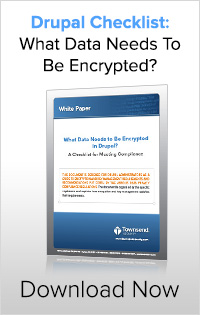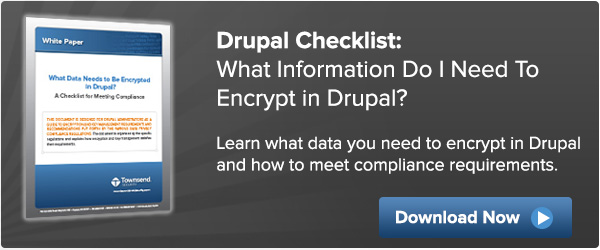"This article was originally posted on Drop Guard’s blog. Drop Guard automates Drupal updates to ensure security of your site within minutes after a security release."

Encryption has gone mainstream. Thanks to the numerous data breaches (781 during 2015 in the U.S. alone) data security is a top priority for businesses of all sizes. Semi-vague language like “we ensure our data is protected” from IT teams is no longer good enough to satisfy the concerns of business executives and their customers. CEOs are losing their jobs and companies are suffering financial losses/fines that reach into the millions of dollars when poorly encrypted or un-encrypted data is lost.
Fortunately, the recent 2016 Global Encryption Trends Study shows that there is a growing shift with businesses developing an encryption strategy – Germany (61%) and the U.S.(45%) are in the lead with the primary drivers including:
- To comply with external or data security regulations
- To protect enterprise Intellectual Property (IP)
- To protect information against specific identified threats
- To protect customer personally identifiable information (PII)
Before getting too much deeper, let’s first clarify a common misperception. Yes, while the big brands are in the headlines, they aren’t the primary target of hackers. A recent threat report from Symantec found that three out of every five cyber-attacks target small and midsize companies. These businesses are targeted because they have weaker security controls and have not taken a defense-in-depth approach to security. Even though some of these businesses may be encrypting their data, chances are they are not doing it correctly.
How do you then define what properly encrypting data involves? First, it means using an industry standard encryption algorithm such as the Advanced Encryption Standard (AES), alternatively known as Rijndael. Standards are important in the encryption world. Standard encryption algorithms receive the full scrutiny of the professional cryptographic community. Further, many compliance regulations such as PCI-DSS, HIPAA/HITECH, FISMA, and others are clear that only encryption based on industry standards meet minimal regulatory requirements. Standards bodies such as NIST, ISO, and ANSI have published standards for a variety of encryption methods including AES.
But wait, my web sites don’t collect credit cards or social security numbers. Why should I care about encryption?
You would be surprised at what can be considered Personally Identifiable Information and should be encrypted. PII now includes information such as (and not limited to):
- Email address
- Password
- Login name
- Date of birth
- Address
- IP address
For a moment, pause and consider how many websites you have built that collect this type of information. As you will quickly realize, even the most basic marketing websites that collect a name and email address should deploy encryption.
Key Management
The second part of properly encrypting data involves key management and understanding the important role that it plays. Your encryption key is all that stands between your data and those that want to read it. So then, what good is a locked door if the key is hidden underneath the “Welcome” mat?
Security best practices and compliance regulations say that encryption keys should be stored and managed in a different location than the encrypted data. This can present a challenge for Drupal developers as the standard has been to store it on the server outside the web root. While there is a suite of great encryption modules (Encrypt, Field Encryption, Encrypted Files, etc.), they unfortunately all stash the key in similar unsecure locations – in the Drupal database, settings file, or in a protected file on the server. Once a hacker compromises a site, they can then take the encryption keys and have access to all the sensitive data.
“Let it Key”
Let’s now bring this back to one of my favorite songs by the Beatles to paraphrase a line (excuse the pun), “Speaking words of wisdom, let it key.” The Key module provides the ability to manage all keys on a site from a singular admin interface. It can be employed by other modules (like the aforementioned encryption modules) to offload key management so the module is not responsible for protecting the key. It gives site administrators the ability to define how and where keys are stored, which, when paired with the proper key storage modules, allows the option of a high level of security and the ability to meet security best practices and compliance requirements. Drupal developers can now easily integrate enterprise level key management systems such as Townsend Security’s Alliance Key Manager or Cellar Door Media’s Lockr (both of these companies have been heavy sponsors of encryption module development).
Enterprise level key managers do more than just store keys outside of the Drupal installation. In addition to safeguarding encryption keys, they manage them through the entire lifecycle—from creation to destruction. Further, a key manager will allow for:
- Key naming and versioning
- Key change and rotation
- Secure key retrieval
- Key mirroring
- Key import and export
- Password and passphrase protection
- User and group control for key access
In addition to providing NIST-compliant AES encryption and FIPS 140-2 compliant key management, an encryption key manager also allows administrators to store their API keys outside of Drupal. Private API keys are frequently used within Drupal by services like Authorize.net, PayPal, MailChimp, etc., and all these modules store their keys in the database in the clear. If your site gets hacked, so does access to the services that you have integrated into your site. For example, if your Amazon S3 API key were in your stolen database, hackers would have access to your entire offsite S3 storage. Consider how detrimental it would be for a client to find out that a hacker has gained access to their PayPal account - after all, they were using PayPal because they didn’t want to deal with the security risks and liability of hosting their own payment processing.
By routing all keys within Drupal to a central key management location, it is now possible to have total control over all encryption keys, API keys, external logins and any other value needing to remain secret. This gives developers and site builders a useful dashboard to quickly see the status of every key, and control where it is stored.
Summary
By now, I have hopefully conveyed the importance of encryption and key management. Everyone from developers to site owners need to understand the importance of data security and the proper steps they can take to keep their site, and their businesses safe. More secure encryption also has an effect on the Drupal platform as a whole. Whether Drupal is being used to create the most basic brochure site or advanced enterprise web application, encryption and API key management are critical to ongoing success. Many businesses don’t care whether their web site is built with Drupal, WordPress, Joomla, or even Microsoft Word (yes this is still possible) as long as it is secure. By integrating the proper security controls, including encryption and key management, Drupal will continue to proliferate and be the tool of choice for enterprises looking for the highest level of data and site security.

